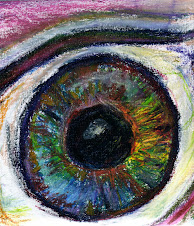Many elementary school math worksheets and tests contain a single sheet of problems arranged in rows and columns. It makes sense. More problems fit on the same page so you save paper. The problems can be solved by working directly on the sheet showing their carries and borrows so that the teacher can easily see if the student knows the concepts and if they deserve partial credit if they got the answer wrong.
But, students whose learning-related visual skills are challenged by ocular motility deficits of either their saccadic or pursuits eye movements may have a very difficult time completing the assignment. Since these students have not yet developed adequate automatic control of their eye muscles (there are six muscles connected to each eye), they may not be able to hold a visual fixation on a single math problem long enough to find it in the first place. So, the paper they turn in may look like a piece of Swiss cheese because so many problems are left undone. In addition, for the same visual reason, these students may start to answer one problem, look away for a second (perhaps to look up while thinking or trying to remember the math fact) and be unable to find the problem again. So the answer to one problem may be written on a different problem nearby.
So, after attacking all the problems (not really) that they perceive, the students assume that they have completed the work and hand it in. "You didn't do all the problems," says the teacher (probably for the 50 thousand time since the year started), surprising and frustrating the student who really really tried. "Go back and finish the paper." A few minutes later, the student returns, again thinking that the whole assignment is done. A few more problems may be, but there are still many left undone, leaving "holes" on the worksheet. Yet, if the teacher points to a problem while the student completes it, or assesses the students' learning another way, these students may be able to show mastery of the mathematical skills that the worksheet was meant to assess.
It isn't that they do not understand how to solve the arithmetic. It could be that they have deficits of their eye movements. They probably are the same students who lose their place when reading, skip little words, and find paper and pencil tasks laborious, frustrating, and terribly time consuming. But, they are obviously intelligent, articulate, and engaged when the learning is delivered and assessed without a need for reading and writing.
These students do not have to spend 12 years of their lives being frustrated and feeling a sense of failure. Recommend that they see a developmental optometrist for a complete binocular vision examination. Then, follow up with in-office vision therapy if it is indicated.
In addition, these students may be assisted to improve their eye muscle control with the activities in the first (Purple Book) of the Eye Can Too! Read series. While the activities are designed with the home school context in mind, many of them are appropriate for use in the regular elementary school classroom. They each serve an academic as well as a visual objective and come with suggestions for what to do when you observe certain behaviors as your students do the activities.
Subscribe to:
Post Comments (Atom)





No comments:
Post a Comment